Your fitness band’s sleep alerts can tell you how long you’ve slept, which sleep stages you’ve experienced, and your overall sleep efficiency by tracking movement patterns and heart rate data. You’ll receive notifications about sleep goals, wake-up timing during ideal light sleep phases, and personalized coaching based on your sleep trends. However, accuracy varies by device – Oura Ring shows 80% agreement with professional sleep studies, while Fitbit struggles with deep sleep detection at only 27-59% sensitivity. Understanding these insights will help you enhance your sleep habits and recognize when professional assessment might be necessary.
Understanding Sleep Stage Detection Capabilities
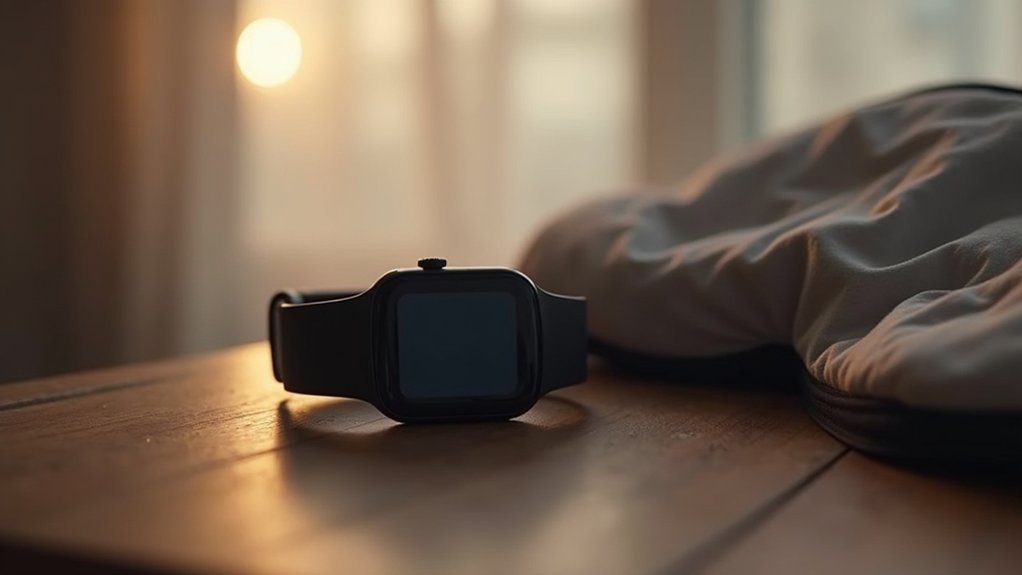
When you’re choosing a fitness band for sleep tracking, you’ll want to understand that these devices vary greatly in their ability to accurately detect different sleep stages.
Not all fitness bands are created equal when it comes to accurately tracking your sleep stages.
Modern devices like the Oura Ring 3 and Fitbit Sense 2 have greatly improved compared to earlier models, but they still don’t match polysomnography (PSG), the gold standard for sleep measurement.
You’ll find that devices perform differently across sleep stages. Fitbit devices typically struggle with deep sleep detection, showing sensitivity ranging from just 27.9% to 59%.
However, some devices excel at detecting light or REM sleep phases. The technology behind detection varies too – some use heart rate variability like WHOOP, while others rely on movement tracking and advanced algorithms to distinguish between sleep stages.
These devices track your sleep cycles approximately every 90 to 110 minutes throughout the night, helping you understand your personal sleep patterns over time.
How Fitness Bands Measure Sleep Duration
Sleep duration measurement represents the foundation of fitness band sleep tracking, relying primarily on movement patterns and heart rate data to determine when you fall asleep and wake up.
Your fitness tracker assumes you’re sleeping when it detects minimal movement for approximately one hour, combined with specific heart rate patterns.
While these devices show impressive sensitivity at 97% for detecting sleep periods, they’re less accurate at identifying wake periods with only 40% specificity. This means your tracker excels at knowing when you’re asleep but struggles to pinpoint exactly when you’re awake during the night.
The accuracy varies considerably between different devices and algorithms. Modern fitness bands collect multiple data points per second using accelerometers, gyroscopes, and photoplethysmography sensors to enhance their sleep detection capabilities. Proper placement and consistent wear improve reliability, though your tracker may underestimate sleep interruptions or overestimate sleep efficiency, affecting total duration calculations.
Light Sleep Vs Deep Sleep Tracking Accuracy
Understanding your sleep quality requires more than just tracking total hours, and fitness bands attempt to differentiate between light and deep sleep stages using heart rate variability, movement patterns, and sophisticated algorithms.
However, you’ll find significant differences in tracking accuracy between these sleep phases.
Sleep stage accuracy varies dramatically, with light sleep detection reaching 81% while deep sleep tracking falls to just 49%.
Your fitness band performs moderately well at detecting light sleep, with devices like Fitbit showing about 81% accuracy. The combination of movement sensors and heart rate fluctuations helps identify these easier-to-detect stages effectively.
Deep sleep tracking proves more challenging. Fitbit’s accuracy drops to approximately 49% for deep sleep detection because algorithms struggle with the complexity of brain activity during this restorative phase.
Without EEG capabilities like polysomnography, your wearable device often overestimates or misclassifies deep sleep periods. The Oura Ring Gen 4 stands out with its sleep staging algorithm that matches the accuracy of professional sleep lab testing.
REM Sleep Monitoring and Its Limitations
Your fitness band’s REM sleep tracking isn’t as reliable as you might think, with most devices correctly identifying only about three out of four REM periods when compared to clinical sleep studies.
You’ll often see your REM sleep misclassified as wake or light sleep, especially if you move around during the night or have fragmented sleep patterns.
These accuracy limitations stem from the fact that your fitness band can’t directly monitor brain activity like medical equipment does, relying instead on movement and heart rate signals that don’t always tell the complete story. Commercial wearables need better sensitivity to accurately detect sleep stages, which affects their ability to properly identify when you’re in different phases of sleep throughout the night.
REM Detection Accuracy
While fitness bands have revolutionized how you monitor your sleep patterns, their ability to accurately detect REM sleep remains considerably limited compared to clinical polysomnography (PSG). Fitbit devices show moderate accuracy with sensitivities reaching 86.5%, while WHOOP trackers display significant discrepancies in REM detection. The Fitbit Charge 4 demonstrates promising results with low disagreement compared to PSG measurements.
Most consumer devices struggle with REM detection challenges because they rely on accelerometry and photoplethysmography rather than thorough brain wave monitoring. These technologies can misinterpret stillness as sleep and lack the precision needed for accurate sleep staging. Combined accelerometry and photoplethysmography achieve sleep staging accuracies between 65-75%.
Despite these limitations, devices like SleepRoutine have achieved high macro F1 scores, indicating improvements in REM sleep detection accuracy are possible.
Common REM Tracking Errors
Despite the promising accuracy improvements in some devices, REM sleep tracking errors remain widespread across consumer fitness bands.
You’ll encounter these common issues that can greatly impact your sleep data’s reliability.
Three Major REM Tracking Errors:
- Movement Misinterpretation – Your device may confuse tossing, turning, or sleep talking with REM interruptions, creating false positives for sleep fragmentation.
- Timing Inaccuracies – Expect up to 38-minute standard deviations in sleep stage timing compared to clinical polysomnography, affecting reported REM duration and episode counts.
- Algorithm Inconsistencies – Different brands use proprietary algorithms that produce varying REM data outputs, even when you’re wearing multiple devices simultaneously.
These errors stem from reliance on indirect signals like heart rate and movement rather than direct brain activity measurement, limiting your device’s ability to accurately identify true REM phases. The time-consuming setup required for many devices can also contribute to user frustration when the resulting data proves unreliable.
Comparing Popular Brands: Fitbit, Oura, and Apple Watch
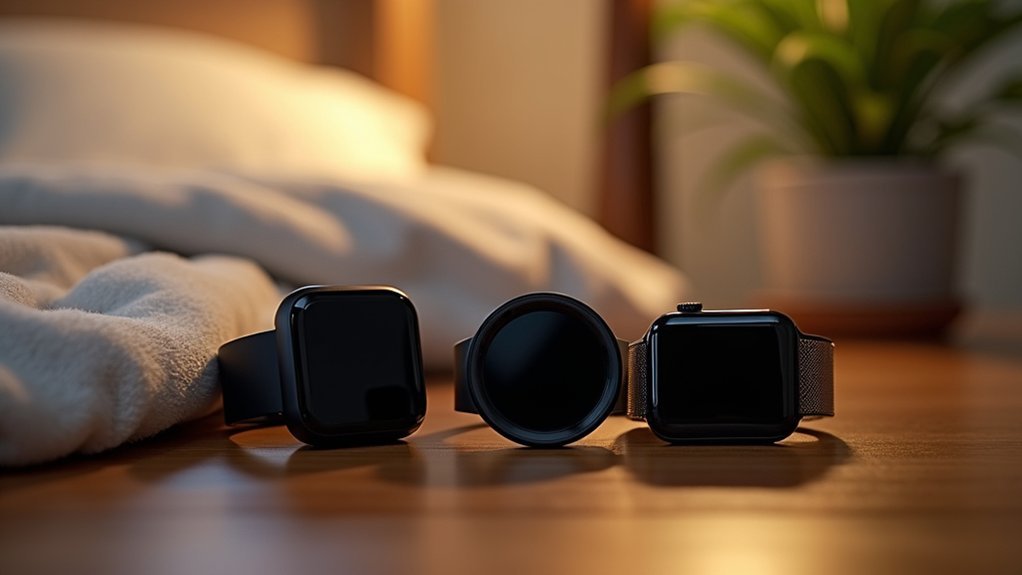
When you’re choosing between Fitbit, Oura, and Apple Watch for sleep tracking, you’ll find considerable differences in how accurately each device detects your sleep stages.
The Oura Ring consistently outperforms both competitors, showing 80% agreement with polysomnography (the gold standard for sleep measurement) while maintaining over 75% sensitivity in detecting all four sleep stages. The Oura Ring was tested by Brigham and Women’s Hospital researchers against both Apple Watch Series 8 and Fitbit Sense 2 in a comprehensive study.
In contrast, Fitbit overestimates light sleep and underestimates deep sleep, while Apple Watch considerably underestimates wake periods and deep sleep stages.
Sleep Stage Accuracy
If you’re relying on your fitness band’s sleep stage alerts to understand your nightly rest patterns, the device you choose makes a significant difference in accuracy.
The Oura Ring consistently outperforms competitors with 76.0-79.5% sensitivity and 77.0-79.5% precision across all sleep stages. It’s 5% more accurate than Apple Watch and 10% more accurate than Fitbit for four-stage sleep classification. These findings come from a single-night study conducted by Brigham and Women’s Hospital that compared all three devices against polysomnography.
Here’s how each device performs:
- Oura Ring – Detects deep sleep with 79.5% sensitivity and wake periods with 68.6% sensitivity, maintaining closest agreement with gold-standard measures.
- Apple Watch – Shows wide precision range (72.7-87.8%) but overestimates light sleep by 45 minutes and deep sleep by 43 minutes.
- Fitbit Sense 2 – Offers moderate performance with 61.7-78.0% sensitivity but overestimates light sleep by 18 minutes.
PSG Comparison Results
Three major fitness bands show dramatically different results when measured against polysomnography (PSG), the gold standard for sleep measurement used in clinical settings.
The Oura Ring Gen 3 demonstrates exceptional accuracy, showing no significant differences from PSG across total sleep time, wake periods, light sleep, deep sleep, REM, and sleep efficiency. It only overestimates sleep latency by about five minutes. Research from Brigham and Women’s Hospital found the Oura Ring achieved up to 10% greater accuracy compared to competing devices.
However, you’ll find notable discrepancies with other devices.
The Fitbit Sense 2 overestimates light sleep by eighteen minutes while underestimating deep sleep by fifteen minutes.
The Apple Watch Series 8 shows larger errors, overestimating light sleep by forty-five minutes and underestimating deep sleep by forty-three minutes.
These differences directly impact the sleep insights and coaching recommendations you’ll receive from each device.
Sleep Quality Metrics Your Device Actually Measures
Your fitness band collects dozens of data points throughout the night, but understanding what these metrics actually represent—and how accurate they are—can help you make better sense of those morning sleep reports.
Most devices track three core categories of sleep data:
- Movement-based metrics – Your band uses accelerometers to detect restlessness, estimate sleep stages, and count nighttime wake-ups, though it may register false positives when you’re lying still but awake.
- Physiological signals – Heart rate, heart rate variability, and breathing patterns help identify sleep disturbances, while some advanced models monitor blood oxygen levels and skin temperature changes.
- Sleep behavior patterns – Duration tracking, sleep regularity scores, and onset latency give you insights into your sleep habits, though accuracy varies considerably compared to clinical sleep studies. Wearable trackers generally provide more accurate readings than bed-based devices because they maintain direct skin contact throughout the night.
Common Overestimations and Underestimations in Sleep Data
While these metrics provide valuable insights into your sleep patterns, fitness bands consistently make predictable errors that can skew your understanding of how well you’re actually sleeping.
Your Fitbit likely overestimates total sleep time by about 10% while underestimating deep sleep and REM by roughly 20% each.
Apple Watch tends to underestimate deep sleep by up to 43 minutes but overestimates light sleep by 45 minutes.
These inaccuracies become more pronounced during sleep stage shifts or frequent awakenings.
The overestimation of total sleep can mask actual sleep deprivation, making you think you’re getting adequate rest when you’re not. When your device shows consistently poor sleep metrics, your account access to health data becomes crucial for identifying patterns that require professional medical consultation.
Understanding these common device biases helps you interpret your sleep data more accurately.
Setting Up Personalized Sleep Alert Preferences
Once you understand your device’s measurement limitations, configuring personalized sleep alert preferences becomes essential for maximizing your fitness band’s effectiveness.
You’ll want to establish consistent sleep and wake times while customizing notification settings to minimize disruptions during rest hours.
Here are three key areas to focus on:
- Sleep Focus Mode Configuration – Activate Sleep Focus Mode to filter notifications and enable Do Not Disturb options that automatically silence calls during your predefined sleep schedule.
- Smart Alarm Optimization – Program smart alarms to wake you during light sleep phases within a preset window, typically 15 minutes before your standard alarm time.
- Display and Brightness Management – Schedule automatic night mode activation and reduce screen brightness to prevent blue light exposure while conserving battery overnight. Access these settings by holding the UP button to navigate through your device’s system menu for comprehensive sleep mode customization.
Wake-Up Timing Notifications Based on Sleep Cycles
Your fitness band analyzes your sleep stages throughout the night to identify ideal wake windows when you’re in lighter sleep phases.
The device detects when you’re shifting out of deep sleep or REM cycles, targeting moments when waking up won’t leave you groggy and disoriented. These smart alarms use pleasant sounds to gently rouse you during your optimal wake window.
Optimal Wake Windows
As your fitness band monitors your sleep throughout the night, it’s tracking the natural rhythm of your 90-120 minute sleep cycles to identify the ideal moments for waking up.
These optimal wake windows occur during light sleep phases when you’re naturally closer to consciousness, making it easier to wake up feeling refreshed rather than groggy.
Your device calculates these windows by analyzing three key factors:
- Sleep cycle completion – Ensuring you’ve finished a full 90-120 minute cycle
- Light sleep detection – Identifying when you’re in the lightest sleep stage
- Circadian rhythm alignment – Matching your body’s natural sleep-wake patterns
Just as babies show signs of fatigue like yawning when they need rest, your fitness band recognizes similar physiological indicators that signal when your body is ready to wake naturally.
Light Sleep Detection
The moment your fitness band detects you’re drifting into lighter sleep phases, sophisticated sensors work together to pinpoint the ideal wake-up opportunity. Your device combines heart rate monitoring, motion detection, and skin temperature readings to estimate when you’re in light sleep—that shallow phase where you’re more easily aroused.
While these wearables can’t measure brainwaves like clinical equipment, they’re surprisingly accurate. Devices like Fitbit achieve around 81% accuracy in detecting light sleep compared to professional sleep studies.
The technology identifies patterns in your reduced movement and physiological changes, then triggers wake-up alerts during these ideal windows. However, like other automated systems, fitness bands can experience software errors that may affect their sleep detection algorithms and wake-up timing accuracy. This smart timing helps you avoid the grogginess that comes from waking during deep sleep, potentially leaving you feeling more refreshed and alert throughout your day.
REM Cycle Timing
Beyond detecting light sleep phases, fitness bands track your REM (Rapid Eye Movement) cycles to deliver even more precise wake-up notifications.
Your device uses algorithms to estimate when you’re in REM sleep, which cycles every 90-120 minutes throughout the night. By timing your alarm to coincide with these lighter sleep stages, you’ll wake up feeling more refreshed and alert.
Here’s how REM-based wake-up timing works:
- Smart alarm windows – Your band adjusts wake times within your preset window to match estimated REM phases
- Reduced sleep inertia – Waking during REM or light sleep minimizes that groggy, disoriented feeling
- Improved morning performance – Studies confirm better cognitive function and mood when awakening aligns with natural sleep cycles
This targeted approach helps optimize your morning alertness. However, consumer fitness bands have limited validity in detecting certain aspects of sleep compared to medical-grade equipment, particularly for measuring sleep onset timing and distinguishing between specific sleep stages.
Sleep Goal Achievement Tracking and Reminders
When you set specific sleep targets on your fitness band, you’re taking the first step toward measurable improvements in your rest quality. Your device tracks progress over time, revealing patterns and trends in your sleep habits that you might otherwise miss.
Modern bands like WHOOP and Oura Ring monitor different sleep stages—light, deep, REM, and awake periods—giving you vital insights into overall sleep quality.
You’ll receive alerts when you don’t meet your goals, along with customizable reminders that help maintain consistent sleep schedules.
Your tracker identifies irregularities and provides personalized coaching based on collected data. You can adjust goals based on device feedback, optimizing wake-up times and receiving suggestions for improving your sleep environment for better rest quality. Advanced devices calculate your individual sleep needs based on your daily strain and activity patterns to provide more accurate sleep targets.
Interpreting Sleep Efficiency Scores and Trends
Since sleep efficiency represents the percentage of time you actually sleep while in bed, understanding this metric becomes essential for evaluating your rest quality. Your fitness band calculates this by dividing your total sleep time by time spent in bed, helping you identify patterns that affect your sleep quality.
Sleep efficiency measures the percentage of time spent actually sleeping versus lying in bed, making it crucial for assessing rest quality.
Several factors influence your sleep efficiency trends:
- Restlessness levels – Increased movement during sleep directly lowers your efficiency scores by reducing actual sleep time.
- Heart rate patterns – Lower sleeping heart rates compared to your daytime resting rate indicate more restful sleep.
- Environmental disruptions – Noise, temperature changes, and light exposure can fragment your sleep patterns.
You’ll notice your scores vary over time due to stress, lifestyle changes, and health conditions, making consistent tracking valuable for improvement. Many manufacturers have transitioned from traditional sleep efficiency calculations to comprehensive Sleep Score systems that incorporate multiple factors beyond just time asleep versus time in bed.
Using Sleep Data to Improve Your Sleep Hygiene
Your fitness band’s sleep data transforms from simple numbers into actionable insights when you use it strategically to enhance your sleep hygiene habits. When your device shows frequent awakenings or irregular bedtimes, it’s highlighting poor sleep patterns that need attention. You can correlate this data with your daily activities—high stress indicators or late workouts might explain restless nights.
| Sleep Data Signal | Hygiene Action |
|---|---|
| Frequent awakenings | Adjust room temperature/noise levels |
| Irregular bedtimes | Establish consistent sleep schedule |
| Low deep sleep | Reduce screen time before bed |
| Poor sleep efficiency | Evaluate mattress/pillow comfort |
Your band’s notifications can prompt earlier bedtimes and better pre-sleep routines. However, keep in mind that fitness bands tend to overestimate sleep efficiency by 1%-15% compared to clinical sleep studies, so interpret the data as general trends rather than precise measurements. Combine this objective data with how you actually feel to create targeted improvements that stick.
When to Trust Your Device Vs Seeking Professional Assessment
While fitness bands provide valuable sleep insights, they’re estimates rather than medical-grade measurements, and understanding their limitations helps you make smarter decisions about when to rely on the data versus consulting a sleep specialist.
You can generally trust your device when you’re a healthy sleeper using it for basic monitoring. Devices like Oura Ring show 50-86% accuracy in sleep stage detection, making them useful for tracking general patterns and daily variations.
However, seek professional assessment if you experience:
- Persistent sleep issues – Devices can’t diagnose sleep disorders like sleep apnea or chronic insomnia.
- Contradictory symptoms – When you feel tired despite your tracker showing “good” sleep.
- Medical concerns – Any sleep-related health problems require polysomnography, the gold standard for accurate diagnosis.
Frequently Asked Questions
Can Sleep Trackers Detect Sleep Disorders Like Sleep Apnea or Insomnia?
You can’t rely on current sleep trackers to diagnose sleep apnea or insomnia. They’ll monitor your sleep patterns and fragmentation, but they lack the precision needed for medical diagnosis without clinical assessment.
How Long Does the Battery Last When Using Continuous Sleep Tracking?
You’ll get 7-14 days of battery life with continuous sleep tracking on most fitness bands. Devices like Amazfit Band 7 last 12 days, while Garmin vívosmart 5 provides about 7 days of tracking.
Do Sleep Trackers Work Accurately for Shift Workers or Irregular Schedules?
Sleep trackers show reduced accuracy for your irregular schedules, struggling with naps and shift patterns. You’ll get better results using manual sleep mode activation and devices with dedicated shift work features.
Can Medications or Alcohol Consumption Affect Sleep Tracker Accuracy?
Yes, medications and alcohol can greatly affect your sleep tracker’s accuracy. Sedatives may make trackers overestimate sleep quality, while stimulants can cause missed wake periods, leading to unreliable data.
Are Sleep Trackers Safe to Wear Every Night Long-Term?
You can safely wear sleep trackers nightly long-term. They’re designed with hypoallergenic materials, emit minimal radiation meeting safety standards, and won’t disrupt your sleep when used properly according to manufacturer directions.

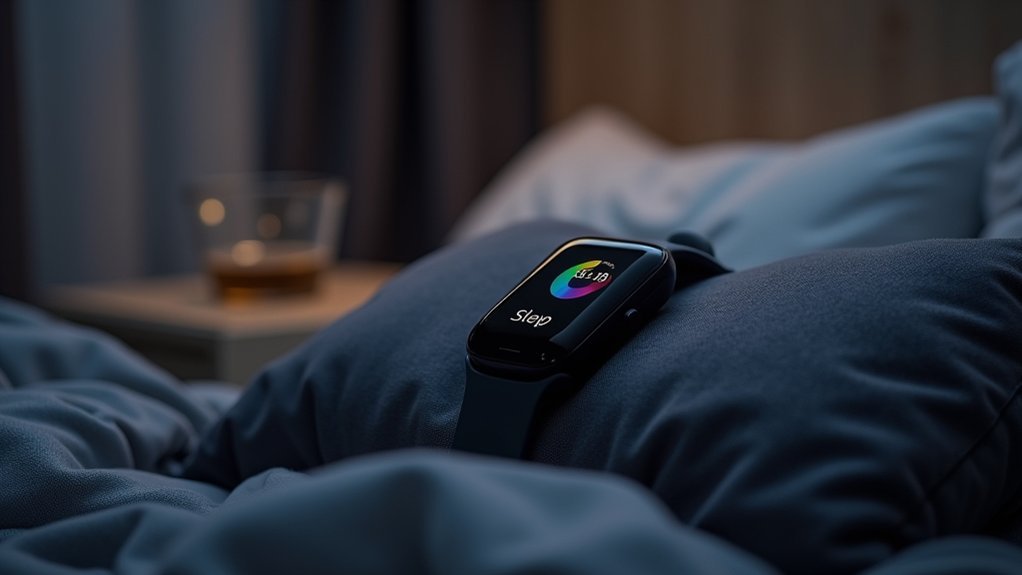
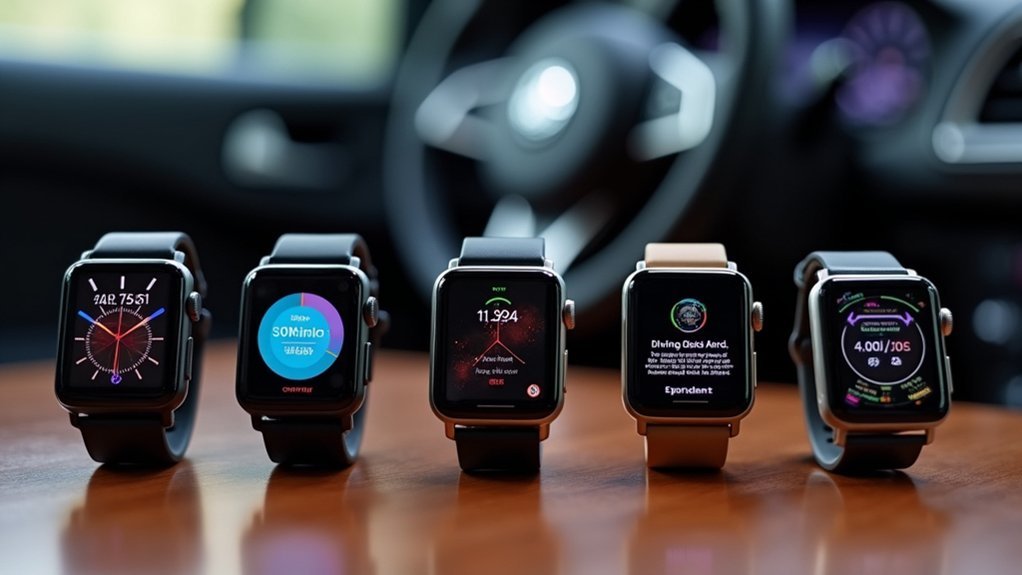
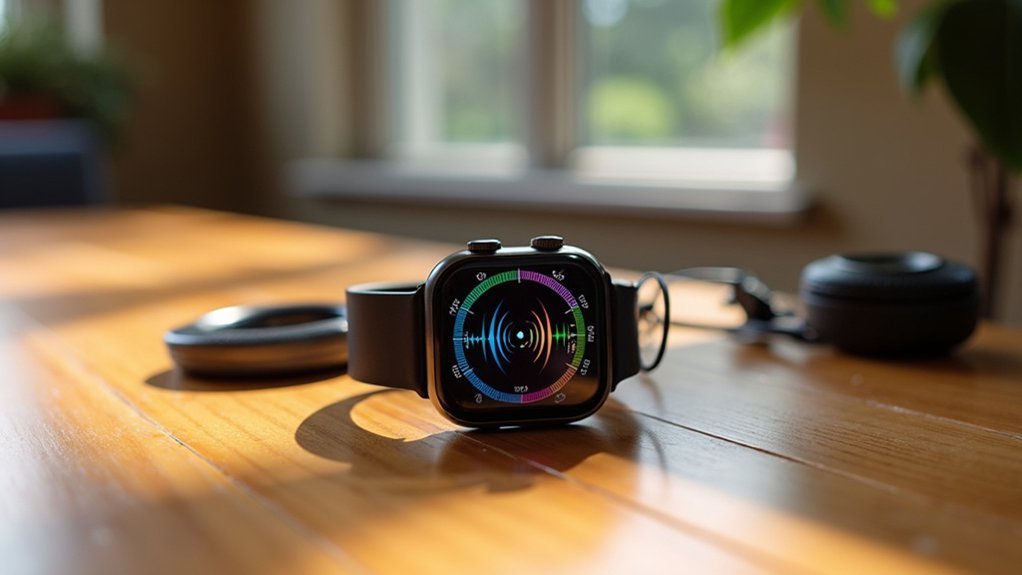
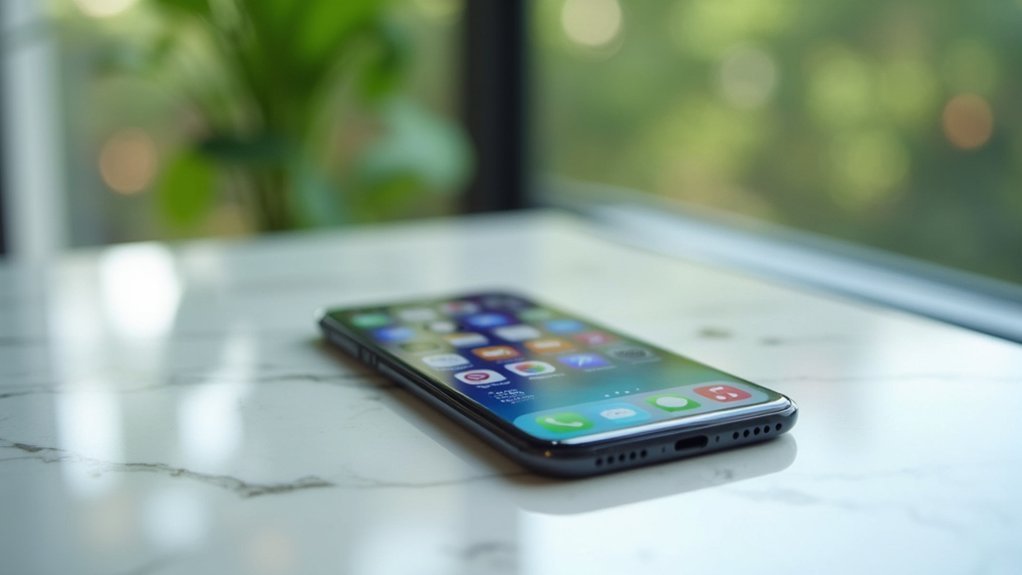
Leave a Reply